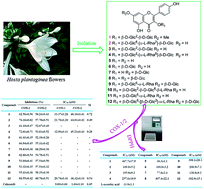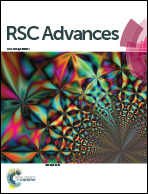Anti-inflammatory and antioxidant activities of flavonoids from the flowers of Hosta plantaginea†
Abstract
Hosta plantaginea was a traditional Chinese medicinal plant used to treat inflammation-related diseases with little scientific validation. Twelve flavonoids, including two new compounds namely plantanones A (1) and B (2), were isolated from the flowers of Hosta plantaginea. Their structures were elucidated by NMR and HRMS as well as comparison with literature data. All of the isolated compounds showed significant inhibitory activities against ovine COX-1 and COX-2 at a concentration of 50 μM, with inhibition ratios from 53.00% to 80.55% for COX-1 and from 52.19% to 66.29% for COX-2. Further detailed testing showed that compounds 1, 2, 4 and 12 inhibited the COX-1 and COX-2 enzymes with IC50 values 12.90–33.37 μM and 38.32–46.16 μM, respectively. Moreover, the antioxidant effects of these isolates against DPPH free radical-scavenging were also evaluated in vitro, and a tight structure-activity relationship was discussed. Our results suggested that the anti-inflammatory and antioxidant activities of H. plantaginea flowers are partly attributed to these flavonoids.



 Please wait while we load your content...
Please wait while we load your content...